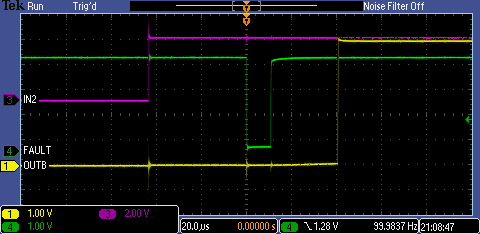Hi, I'm using an DRV8832 to switch a small solenoid back and forth at a rate of 10 Hz.
I use In1, In2 = 0, 0; 1, 0; 0,0; 0,1 ... i.e. standby, fwd, standby, reverse...
Everytime I switch, the FAULTn signal is asserted for 6 us and this occurs 43 us after IN1 or IN2 is asserted. It doesn't matter if the solenoid is connected to the board or not. The power supply is stable at 5.0 V and the DRV8832 is decoupled with 100 nF. Vref and Vset is connected together. Iref is connected to gnd. FAULTn is pulled up with 1kohm.
The solenoid is switching as expected.
Is this 6 us FAULTn pulse normal behaivor? If not, what can be the problem?
Best regards, Tomas


